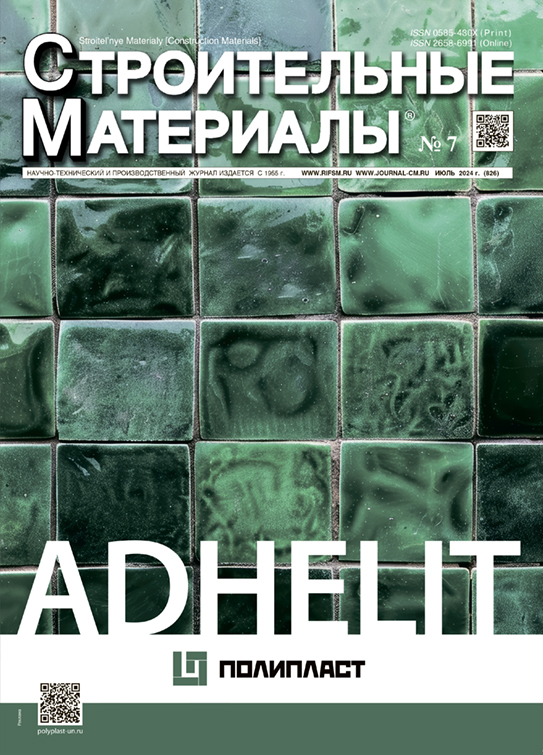Optimizing the Compositions of Plaster Mixtures Based on Gypsum Binder Using REOLIN RA 120
- Authors: Araslankin S.V.1, Buryanov A.F.2, Shchankin M.V.1
-
Affiliations:
- Exponenta LLC
- National Research Moscow State University of Civil Engineering
- Issue: No 7 (2024)
- Pages: 18-25
- Section: To Holding the XXIV International Conference of Manufacturers of Dry Building Mixes BALTIMIX-2024 (Perm, 20-23 August)
- URL: https://journals.eco-vector.com/0585-430X/article/view/635035
- DOI: https://doi.org/10.31659/0585-430X-2024-826-7-18-25
- ID: 635035
Cite item
Abstract
The issue of the limit of technical and economic optimization of dry building mixes compositions does not lose its relevance and remains one of the main and priority issues in the industry. One of the ways to solve this issue is to use the most advanced chemical additives that minimize the cost of mixtures while maintaining the characteristics of the products. This paper discusses the use of rheological additive REOLIN RA 120 to optimize the compositions of plaster mixtures based on gypsum binder. It is shown that the use of REOLIN RA 120 in gypsum compositions reduces the complexity of plastering by increasing the range of permissible water-solid ratio, reducing the consumption of dry mix and improving the surface texture. The algorithm of introducing the additive and its effect on the indicators characterizing the complexity of preparation, application, leveling of the solution and subsequent treatment of the plaster surface is described.
Full Text
About the authors
S. V. Araslankin
Exponenta LLC
Author for correspondence.
Email: ceo@sci-exp.ru
CEO
Russian Federation, RuzaevkaA. F. Buryanov
National Research Moscow State University of Civil Engineering
Email: rga-service@mail.ru
Doctor of Sciences (Engineering)
Russian Federation, MoscowM. V. Shchankin
Exponenta LLC
Email: lab@sci-exp.ru
Candidate of Sciences (Biology), Senior Researcher
Russian Federation, RuzaevkaReferences
- Dergunov S.A., Rubtsova V.N. Proyektirovaniye sostavov sukhikh stroitelnykh smesey [Design of formulations of dry building mortars]. Orenburg: OGU, 2007. 97 p.
- Denisov G.A. Manufacturing and using of dry mixes. Suxie stroitel’nye smesi. 2011. No. 1, pp. 14–17. (In Russian).
- Zagorodnyuk L.X., Lesovik V.S., Gajnutdinov R. Specifics of hardening of mortars based on dry mixtures. Vestnik of the Central Regional Branch of the RAASN. Belgorod. 2014. Iss. 13, pp. 93–98. (In Russian).
- Chen X., Wu S. Influence of water-to-cement ratio and curing period on pore structure of cement mortar. Construction and Building Materials. 2013. Vol. 38. No. 6, pp. 804–812. https://doi.org/10.1016/j.conbuildmat.2012.09.058
- Chen N., Wang P., Zhao L., Zhang G. Water retention mechanism of HPMC in cement mortar. Materials. 2020. Vol. 13. No. 13, 2918. https://doi.org/10.3390/ma13132918
- Elistratkin M.Yu., Minakova A.V., Dzhamil A.N., Kukoviczkij V.V., Elyan I.Zh.I. Composite binders for finishing compositions. Stroitel’ny’ materialy i izdeliya. 2018. No. 1 (2), pp. 37–44. (In Russian).
- Wong H. H. C., Kwan A. K. H. Rheology of cement paste: role of excess water to solid surface area ratio. Journal of materials in civil engineering. 2008. Vol. 20. No. 2, pp. 189–197. https://doi.org/10.1061/(ASCE)0899-1561(2008)20:2(189)
- Dvorkin L.I., Dvorkin O.L. Stroitel’noe materialovedenie [Construction materials science]. Moscow: Infra-Inzheneriya. 2013. 832 p.
- Araslankin S.V., Kostryukov S.G., Tomilin O.B. Modern methods in technical and economic optimization of compositions of dry mixtures (Part I). ALITinform: Cement. Beton. Suxie smesi. 2018. No. 3 (52), pp. 54–66. (In Russian).
- Araslankin S.V., Kostryukov S.G., Tomilin O.B. Modern methods in technical and economic optimization of compositions of dry mixtures (Part II). ALITinform: Cement. Beton. Suxie smesi. 2019. No. 1 (54), pp. 56–65. (In Russian).
- Araslankin S.V., Kostryukov S.G., Tomilin O.B. Kinetic model of structure formation of dispersed systems based on calcium sulphate halfhydrate in the presence of mixed cellulose ethers. Increasing the efficiency of production and use of gypsum materials and products: materials of the IX International Scientific and Practical Conference. Minsk. 2018, pp. 20–28. (In Russian).
- Gumerova E.I., Gamayunova O.S. Methods of plastering works. Stroitel’stvo unikal’nyx zdanij i sooruzhenij. 2016. No. 7 (46), pp. 7–16. (In Russian).
- Murtazaev S.-A.Yu., Uspanova A.S., Khadzhiev M.R. Analysis of technology for producing plastering works by manual and mechanized methods. Vestnik GGNTU. Texnicheskie nauki. 2020. No. 16 (3), pp. 59–64. (In Russian).
- Pol’nikov A.A. Features of determining the quality of dry construction mixture. Stroitel’nye Materialy [Construction Materials]. 2010. No. 2, pp. 40–41. (In Russian).
- Dvorkin O.L. Application of dry building mixes at the present stage. Suxie stroitel’nye smesi. 2011. No. 2, pp. 20–23. (In Russian).
- Cherednichenko T.F., Mamirgov M.U. Improvement of modern technologies for the production of plastering works. Vestnik of the Volgograd State University of Architecture and Civil Engineering. Series: Construction and Architecture. 2020. No. 4 (81), pp. 274–282. (In Russian).
- Nekrasova S.A., Garkavi M.S., Buldy’zhova E.N. Dry building mixtures based on stabilized gypsum binder. Stroitel’nye Materialy [Construction Materials]. 2014. No. 7, pp. 32–33. (In Russian).
- Potapova E. Texnologiya suxix stroitel’ny’x smesej [Technology of dry building mixtures]. Moscow: Infra-Inzheneriya. 2023. 376 p.
- Zagorodnyuk L.H., Lesovik V.S., Glagoev E.S., Volodchenko A.A., Voronov V.V., Kucherova A.S. Theoretical foundations of the creation of dry building mixes. Vestnik of the Belgorod State Technological University named after V.G. Shukhov. 2016. No. 9, pp. 40–52. (In Russian).
- Patent № 2659432 C1. Regulyator reologicheskix svojstv dispersny’x sistem na osnove neorganicheskix vyazhushhix veshhestv [Rheology regulator for inorganic binder-based dispersion systems]. Araslankin S.V., Tomilin O.B. Declared 10.04.2017. Published. 02.07.2018.
Supplementary files








